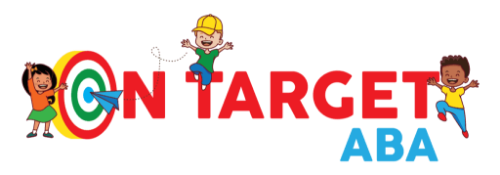🧠 AI Summary:
This blog is for parents who are beginning to notice signs that their child may have autism but aren’t sure what to do next. It walks through how to recognize early signs, how to get an evaluation, and how ABA therapy can help even before a diagnosis is finalized. The article emphasizes reassurance, practical next steps, and how early intervention builds lasting progress.
When You First Begin to Wonder
Every parent has that moment.
You notice your toddler isn’t talking as much as other kids their age, or they don’t respond when you call their name. Maybe they line up toys in a perfect row or get upset when their routine changes.
You start wondering:
💭 “Are these signs my child needs ABA therapy?”
The truth is — you’re not alone. Many parents feel unsure at first, and asking this question is already an important step toward helping your child.
At On Target ABA, we work with hundreds of families who started exactly where you are now — concerned, uncertain, and ready to find answers.
Recognizing the Early Signs of Autism
Every child develops at their own pace, but certain patterns can suggest developmental differences worth exploring. Some early signs of autism may include:
- Limited eye contact or response to name
- Few or no words by age two
- Repetitive movements (like hand-flapping or rocking)
- Strong preferences for routines
- Difficulty engaging in pretend play
- Limited interest in peers
- Unusual reactions to sound, touch, or light
These signs don’t always mean autism — but they do mean it’s time to look a little closer.
Early awareness allows you to begin evaluations and intervention as soon as possible, which research shows leads to stronger long-term outcomes.
According to the CDC, early identification and behavioral therapy can greatly improve communication, learning, and social skills.
Step 1: Talk to Your Pediatrician
If you’re seeing some of these early indicators, your first step is to schedule an appointment with your child’s pediatrician.
Share your observations clearly. You might say:
“My child doesn’t respond to their name or make eye contact often. Should we do a developmental screening?”
Most pediatricians use standardized screening tools around 18–24 months, but you can request one earlier if you’re concerned.
If the screening shows developmental delays, your doctor will refer you for a comprehensive autism evaluation — usually performed by a developmental pediatrician, child psychologist, or neurologist.
Step 2: Getting an Autism Diagnosis
The autism diagnosis process may sound complicated, but it’s actually very structured. It often includes:
- A developmental history review
- Direct behavioral observation
- Cognitive and language assessments
- Parent questionnaires and interviews
The goal isn’t to label your child — it’s to understand how they learn best and what supports will help them thrive.
Once your child receives a diagnosis, you’ll get a written evaluation report, which you can use to begin services like ABA therapy, speech therapy, or occupational therapy.
Step 3: Don’t Wait to Start Help
Here’s something many parents don’t realize:
You don’t always need to wait for an official diagnosis to begin early support.
If you’ve already started asking questions like “What are the signs my child needs ABA therapy?” — that’s a good signal to reach out.
At On Target ABA, our team can help guide you through the process, even before formal paperwork is finalized. We often begin with skill assessments and parent coaching to support developmental growth right away.
Research consistently shows that children who receive early intervention — even before age three — make greater gains in communication, learning, and adaptive skills.
What Is ABA Therapy and How Does It Help?
It focuses on:
- Communication (like learning to request needs or start conversations)
- Social skills (like sharing, turn-taking, or playing with peers)
- Behavioral regulation (like handling transitions calmly)
- Daily living skills (like brushing teeth, dressing, or feeding independently)
So, if you’ve been wondering whether the signs your child needs ABA therapy are showing — ABA can provide the tools to turn those challenges into progress.
Step 4: Getting an ABA Evaluation
Once you have your autism diagnosis (or even if it’s still pending), the next step is to schedule an ABA evaluation.
At On Target ABA, this includes:
- A meeting with a Board Certified Behavior Analyst (BCBA)
- Direct interaction with your child to identify strengths and challenges
- Setting short- and long-term goals
- Creating a personalized treatment plan
This assessment forms the foundation for your child’s therapy journey — and it can often be submitted directly to your insurance provider for coverage approval.
Step 5: Understanding Insurance Coverage
Many families worry about the cost of therapy — but thankfully, ABA therapy is now widely covered by insurance, including Medicaid and most private plans.
You’ll typically need to provide:
- Your insurance card
- Autism diagnosis report
- Physician referral (if required)
Our On Target ABA intake team handles all the paperwork — verifying benefits, submitting authorizations, and explaining coverage details.
Learn more about Medicaid ABA therapy and how we support families through the process.
When You’re Unsure: Trust Your Instincts
Sometimes parents hesitate to reach out because they’re unsure whether their child “really needs therapy.”
But here’s the truth: starting early can only help.
ABA therapy isn’t just for confirmed autism diagnoses — it can also benefit children who show developmental delays in communication, focus, or behavior.
As one of our BCBAs often says:
“It’s never too early to start helping your child build confidence and independence.”
What If It’s Not Autism?
Even if your child’s evaluation shows developmental differences but not autism, you still have options for early intervention.
Other therapies may include:
- Speech therapy for communication or articulation delays
- Occupational therapy for fine motor or sensory challenges
- Social skills groups for building peer connections
The important thing is to act early — because intervention at the right time can make a world of difference in your child’s long-term development.
The Role of Parents in Early Support
Parents play the most powerful role in early learning. Whether you’re waiting for a diagnosis or just starting therapy, you can help by:
- Narrating daily routines (“We’re putting on shoes now!”)
- Offering choices (“Do you want the blue cup or the red cup?”)
- Celebrating small successes
- Building consistent routines
- Encouraging play and curiosity
At On Target ABA, we partner with parents through training, feedback sessions, and simple strategies that make home life easier and more positive.
You’re Not Alone — We’re Here to Help
If you’ve reached this point, it means you’re already taking action — and that’s something to be proud of. 💙
Whether your child has a confirmed diagnosis or you’re still in the evaluation phase, On Target ABA is here to walk with you every step of the way.
We’ll help you navigate:
✅ The autism diagnosis process
✅ Insurance verification and Medicaid coverage
✅ Personalized ABA therapy designed for your child
✅ Parent training to bring progress home
You can start by reaching out to your nearest center:
Because the earlier you start, the brighter your child’s path becomes. 🌟

